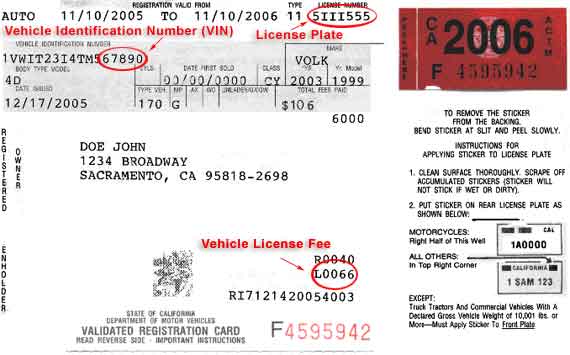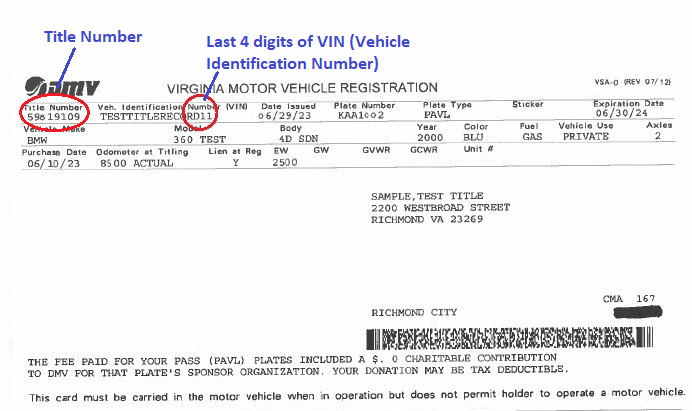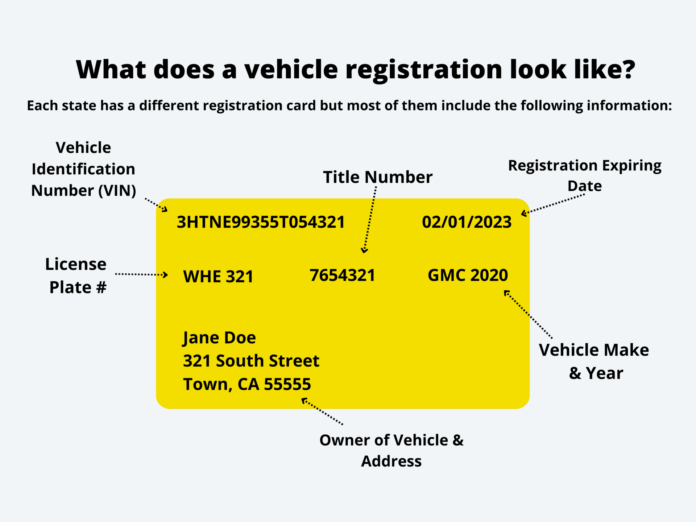A car registration typically includes the license plate number, county of registration, and partial vehicle identification number. This information is displayed on a sticker placed on the vehicle, serving as proof of registration.
In Texas, registration expires on the last day of the month shown on the sticker. It is essential to keep the registration receipt in the vehicle at all times. This not only helps in case of any verification needs but also protects against theft and fraud.
Understanding what a car registration looks like is crucial for compliance with state regulations and ensuring your vehicle is properly registered.
Introduction To Car Registration
A car registration typically includes a sticker displaying the license plate number, county of registration, and partial vehicle identification number. This sticker, customized for security, indicates the expiration date. In Texas, the registration receipt serves as proof of registration and is recommended to be kept in the vehicle.
Purpose Of Vehicle Registration
Car registration is a legal requirement that every vehicle owner must fulfill in order to drive their vehicle on public roads. The main purpose of vehicle registration is to ensure that all vehicles on the road are safe and meet the minimum standards set by the government. This includes verifying that the vehicle is insured, has passed a safety inspection, and is not stolen.General Components Of A Registration Document
A car registration document is an official document issued by the government that contains important information about the vehicle and its owner. The general components of a registration document include the vehicle identification number (VIN), license plate number, make and model of the vehicle, and the name and address of the owner. It also includes the date of registration and expiration date of the registration. In some states, the registration document may also include information about the vehicle’s weight, fuel type, and emissions rating. In addition to the registration document, vehicle owners are also issued a registration sticker that must be displayed on the vehicle’s windshield or license plate. This sticker indicates that the vehicle has been registered and is legal to drive on public roads. It is important to keep the registration document and sticker up-to-date and renew the registration on time to avoid any legal penalties or fines. In some states, a renewal notice is sent to the vehicle owner to remind them of the upcoming expiration date. Overall, understanding the components of a car registration document and the purpose of vehicle registration is essential for every vehicle owner. It ensures that their vehicle is legal to drive on public roads and meets the minimum safety standards set by the government.
Credit: www.wheelsforwishes.org
Physical Characteristics
Physical Characteristics:
Standard Dimensions And Layout
A car registration typically consists of a rectangular-shaped document that is around 4 inches by 6 inches in size. It contains essential information such as the vehicle owner’s name, address, license plate number, and registration expiration date. The layout is standardized to ensure consistency and easy identification.
Security Features To Prevent Fraud
- One of the key security features of a car registration is the use of special holograms or watermarks that are difficult to replicate, making it challenging for counterfeiters to produce fake registrations.
- Additionally, unique barcodes or QR codes may be included on the document to allow authorities to verify its authenticity quickly.
- Some registrations also have embedded microtext or fine print that is only visible under magnification, adding another layer of security to prevent fraud.
Key Information Displayed
When you receive your car registration, it’s important to understand the key information displayed on the document. This includes crucial details such as the vehicle identification number (VIN), license plate number, and expiration date with renewal information.
Vehicle Identification Number (vin)
The Vehicle Identification Number (VIN) is a unique code assigned to every motor vehicle when it’s manufactured. It serves as the vehicle’s fingerprint, providing crucial information about its make, model, and features. The VIN displayed on your car registration document is essential for various purposes, including vehicle history checks and ownership verification.
License Plate Number
The license plate number is a prominent feature on the car registration document. It uniquely identifies your vehicle and is used for identification by law enforcement, parking authorities, and other relevant entities. It’s essential to ensure that the license plate number on your registration matches the physical license plate on your vehicle.
Expiration Date And Renewal Information
The car registration includes the expiration date, indicating the last day of the month when the current registration period ends. Additionally, it provides important renewal information, such as the process for renewing the registration and any associated deadlines or requirements. Staying informed about the expiration date and renewal process is crucial to maintaining valid registration for your vehicle.

Credit: www.dmv.virginia.gov
Variations Across States
Car registration documents vary across states in the United States. Each state has its own set of guidelines and requirements for vehicle registration, which results in variations in the appearance and content of registration documents.
Comparing Registration Documents
When comparing registration documents from different states, one can observe differences in layout, format, and information included. Some states may have more detailed registration documents, while others may have a more simplified version with basic information.
State-specific Requirements
Each state imposes specific requirements for car registration documents. These requirements may include the inclusion of certain information, such as vehicle identification number (VIN), owner details, expiration date, and county of registration. Additionally, states may have unique formatting and design elements for their registration documents.
Electronic Vs. Physical Copies
When it comes to car registration, there are two main formats: electronic and physical copies. Each has its own set of advantages and legal considerations that drivers should be aware of.
Accessing Digital Registration
With the advancement of technology, many states now offer digital or electronic copies of car registrations. These digital copies can typically be accessed through the state’s Department of Motor Vehicles (DMV) website or mobile app. Once accessed, drivers can view, download, and print their electronic registration for their convenience.
Legal Requirements For Carrying Your Registration
It is important for drivers to be aware of the legal requirements for carrying their car registration. In many states, including Texas, drivers are required to carry a physical or digital copy of their registration in their vehicle at all times. This serves as proof of registration and is necessary to present to law enforcement upon request.
Registration Stickers
Registration stickers are a vital part of a vehicle’s registration process. They serve as a visual indication that a vehicle has been registered and is legally allowed to be on the road. Understanding the details on these stickers is essential for every vehicle owner.
Placement And Purpose
The placement of registration stickers is usually on the vehicle’s license plate or windshield, depending on the state regulations. The purpose of these stickers is to provide a clear indication of the vehicle’s registration status and expiration date. This helps law enforcement officers and other authorities to easily verify the vehicle’s compliance with registration requirements.
Understanding The Details On Stickers
Registration stickers typically display the license plate number, county of registration, and a partial vehicle identification number. This information is customized to provide added protection against theft and fraud. It’s important for vehicle owners to be able to recognize and understand the details on their registration stickers.
Renewing Your Registration
A car registration typically includes the license plate number, county of registration, and a partial vehicle identification number. This information is displayed on the registration sticker, which helps protect against theft and fraud. The registration expires on the last day of the month shown on the sticker.
Step-by-step Renewal Process
Renewing your car registration is a straightforward process that can be done online, by mail, or in person. To ensure a smooth renewal, follow these steps:
- Check your renewal notice or current registration for important dates and details.
- Gather necessary documents such as proof of insurance and emissions test results.
- Visit the official DMV website or local office to initiate the renewal process.
- Verify your personal information and pay the renewal fees.
- Receive your new registration documents either electronically or by mail.
Dealing With Expired Registration
If your car registration has expired, take immediate action to avoid fines or penalties. Follow these steps:
- Contact your local DMV to inquire about renewal options for expired registrations.
- Prepare to pay any late fees or penalties associated with the expired registration.
- Provide the necessary documentation and complete the renewal process promptly.
- Once renewed, ensure your new registration sticker is prominently displayed on your vehicle.
Troubleshooting Common Issues
A car registration in Texas consists of a sticker displaying the license plate number, county of registration, and partial vehicle ID. This unique customization helps prevent theft and fraud, with registration expiring on the last day of the indicated month.
Troubleshooting Common Issues When it comes to car registration, there can be a few common issues that you may run into. Whether you have lost your registration or need to correct an error, it’s important to know what to do. In this section, we’ll go over some of the most common issues you may face and how to troubleshoot them. H3: Lost or Stolen Registrations If you have lost your car registration, or it has been stolen, you will need to get a replacement. In Texas, you can request a replacement registration online, by mail, or in person at your local county tax office. You will need to provide your vehicle information and pay a fee to obtain a replacement. H3: Correcting Errors on Your Registration If you notice an error on your car registration, it’s important to correct it as soon as possible. Errors can include incorrect vehicle information, misspelled names, or incorrect fees. To correct an error, you will need to contact your local county tax office and provide the correct information. Depending on the error, there may be a fee to correct it. In conclusion, it’s important to ensure that your car registration is accurate and up-to-date. If you run into any issues, such as a lost or stolen registration or an error on your registration, be sure to take the necessary steps to correct it. By doing so, you can avoid potential fines or legal issues and ensure that your vehicle is properly registered.
Credit: www.carfax.com
Frequently Asked Questions
What Is Proof Of Registration In Texas?
Proof of registration in Texas is a receipt stored in the vehicle, serving as proof of registration.
What Does My Texas Car Registration Look Like?
Your Texas car registration includes the license plate number, county of registration, and partial vehicle identification number. The registration sticker helps protect against theft and fraud, and expires on the last day of the month shown.
How Can I Get A Copy Of My Vehicle Registration In Texas?
To get a copy of your vehicle registration in Texas, visit the Texas Department of Motor Vehicles website.
Is Texas Vehicle Registration Just A Sticker?
No, Texas vehicle registration is not just a sticker. The registration sticker displays your license plate number, county of registration, and partial vehicle identification number. It serves as proof of registration, and is recommended to be retained in the vehicle.
Registration expires on the last day of the month shown on your sticker.
Conclusion
Understanding what a car registration looks like is essential for all vehicle owners. It contains crucial information like the license plate number and expiration date. Familiarizing yourself with the appearance of a car registration can help ensure compliance with state laws and avoid potential legal issues.
Keep your registration documents safe and easily accessible for peace of mind on the road.


